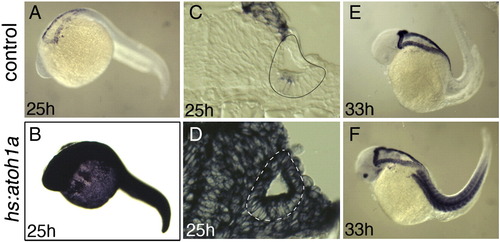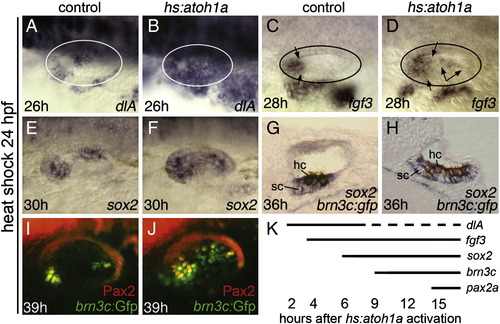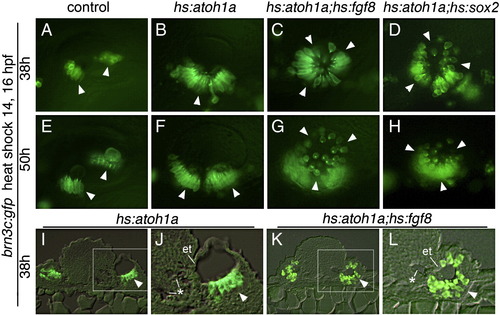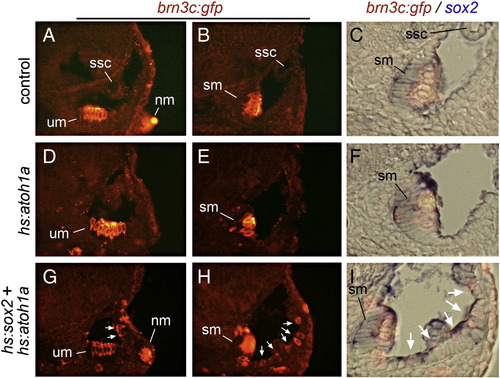- Title
-
Sox2 and Fgf interact with Atoh1 to promote sensory competence throughout the zebrafish inner ear
- Authors
- Sweet, E.M., Vemaraju, S., and Riley, B.B.
- Source
- Full text @ Dev. Biol.
|
atoh1a expression following hs:atoh1a activation at 24 hpf. Expression of atoh1a at the indicated times in control embryos (A, C, E) and hs:atoh1a transgenic embryos (B, D, F). Images of wholemount specimens (A?B, E?F) are dorsolateral views with anterior to the left and transverse sections (C?D) with dorsal to the top. The otic vesicles are outlined in C?D. |
|
Otic vesicle patterning following hs:atoh1a activation at 18 hpf. (A?F) Expression of brn3c:gfp (green) in the utricle and saccule of control embryos (A, C, E) and in hs:atoh1a transgenic embryos (B, D, F) at the indicated times. (E, F) Co-staining with anti-Pax2 in red. (G?L) Otic expression of fgf3, fgf8, and pax5 in control embryos (G, I, K) and expanded expression in hs:atoh1a transgenic embryos (H, J, L). All images show dorsolateral views with anterior to the left and dorsal up (A?H) or dorsal views with anterior to the left and medial up (I?L). |
|
Otic vesicle patterning following hs:atoh1a activation at 24 hpf. (A?F) Expression at the indicated times of dlA, fgf3 and sox2 in control embryos (A, C, E) and hs:atoh1a transgenic embryos (B, D, F). To assist in interpretation of images, otic vesicles are outlined in A?D and the spatial limits of fgf3 expression are marked by arrows (C, D). (G, H) Transverse sections showing expression of sox2 (blue) and anti-GFP (brown) at 36 hpf in a control embryo (G) and a hs:atoh1a transgenic embryo (H). Positions of hair cells (hc) and support cells (sc) are indicated. (I, J) Expression of brn3c:gfp (green) and Pax2 (red) in otic hair cells at 39 hpf in a control embryo (I) and a hs:atoh1a transgenic embryo (J). (K) Summary of the onset of expanded or ectopic expression of various otic markers following activation of hs:atoh1a at 24 hpf. Most markers were stably expressed, except for dlA. Expression of dlA was lost in a subset of cells after several hours, presumably reflecting the process of lateral inhibition. Images of wholemount specimens (A?F, I, J) are dorsolateral views with anterior to the left and dorsal to the top. |
|
Spatial restriction of competence to respond to hs:atoh1a at different stages. Expression of brn3c:gfp in control embryos (A?D) and hs:atoh1a transgenic embryos (E?H). Embryos were heat shocked at the times indicated across the top and photographed 12?13 h later. Arrowheads mark positions of endogenous and expanded sensory epithelia. Images show dorsolateral views with anterior to the left and dorsal to the top. |
|
Co-misexpression of atoh1a with fgf8 or sox2. (A?L) Expression of brn3c:gfp after serial heat shock at 14 and 16 hpf in a control (A, E), hs:atoh1a (B, F, I, J), hs:atoh1a;hs:fgf8 (C, G, K, L) and hs:atoh1a;hs:sox2 (D, H) embryos. Embryos were fixed and processed at the indicated times. Arrowheads mark positions of endogenous and ectopic sensory epithelia. Images in I?L show transverse sections with dorsal to the top. The boxed areas in I and K are enlarged in J and L, respectively. The hindbrain shows sporadic formation of microvesicles (asterisks), suggesting tissue disruption, and the adjacent wall of the otic vesicle shows marked epithelial thinning (et). All other images show dorsolateral views, with anterior to the left and dorsal to the top. |
|
Axial patterning following co-activation of hs:atoh1a and hs:fgf8. Expression of various otic markers in control embryos (A?J), hs:atoh1a transgenic embryos (A′?J′) and hs:atoh1a;hs:fgf8 double transgenic embryos (A′′?J′′). Embryos were serially heat shocked at 14 and 16 hpf and fixed for processing at 26 hpf. Images show dorsal views (A?C′′) or dorsolateral views (D?J′′), with anterior to the left. Circles outline the otic vesicle. Arrowheads in E?E′′ mark expected location of fsta in the posterior otic vesicle. Arrowheads in J?J′′ indicate expanded domains of pax2a in the lateral wall of the otic vesicle. |
|
Sox2 expands sensory competence at later stages. Transverse sections showing otic expression of brn3c:gfp (red) and sox2 (blue) in a control embryo (A?C), a hs:atoh1a transgenic embryo (D?F) and a hs:atoh1a;hs:sox2 double transgenic embryo (G?I). Embryos were serially heat shocked at 45 and 48 hpf and fixed at 72 hpf for staining and sectioning. Shown are sections passing through the anterior end (A, D, G) or the posterior end (B, C, E, F, H, I) of the otic vesicle. Positions of the utricular macula (um), saccular macula (sm), semicircular canals (ssc) and lateral line neuromasts (nm) are indicated. White arrows (G?I) mark ectopic hair cells. Specimens in C, F, and I are enlargements of images B, E, and H, respectively and are shown in brightfield with fluorescence to clarify the spatial relationship between hair cells and sox2 expression. |
Reprinted from Developmental Biology, 358(1), Sweet, E.M., Vemaraju, S., and Riley, B.B., Sox2 and Fgf interact with Atoh1 to promote sensory competence throughout the zebrafish inner ear, 113-21, Copyright (2011) with permission from Elsevier. Full text @ Dev. Biol.







